what fish is illegal to own in washington state
Invasive species threatens fisheries in Washington
Lurking, and apparently thriving, under the tranquillity, shallow shoreline waters of Lake Roosevelt in Northeastern Washington is an aggressive, invasive predator that has the potential to upset billions of dollars of investment to rebuild native fish populations including redband trout, kokanee, white sturgeon, burbot, and perchance salmon and steelhead.
In response to an emergency that i member of the Northwest Ability and Conservation Council likened to a house fire, a pitched battle is being waged in the northern department of the breathtaking, 151-mile-long lake confronting the invader, Northern Pike, with gillnets, a no-limit, "catch and kill" fishery, and a advantage fishery that pays $10 for each thruway caput turned in by anglers. Scientific research is also part of the strategy to acquire more about the species and how they got in Lake Roosevelt, and how best to control them.
The aim is to beat downwardly the population, protect important fisheries and native fish in the lake, and keep pike from establishing in the Columbia River or tributaries downstream of Primary Joseph Dam, where country and federal fish and wild fauna agencies and tribes are working to restore habitat and heave populations of salmon and steelhead, including endangered species.
In that location is no question the Lake Roosevelt thruway population is exploding, or is nigh to. Hundreds of juvenile motorway are stunned during regular electrofishing patrols and scooped from shallow backwaters along the lake shore.
"We knew we had a potential problem when in the fall of 2014 adult pike started actualization in our sampling efforts for juvenile white sturgeon," said Dr. Brent Nichols, the Fisheries Managing director for the Spokane Tribe of Indians. "And then in the leap of 2015 when we started receiving reports of anglers targeting Northern Thruway near Kettle Falls, the Lake Roosevelt co-managers met to develop a response plan." Those co-managers include the Spokane Tribes, the Colville Confederated Tribes, and the Washington Section of Fish and Wild animals.
Huge pike several years quondam and weighing over twenty pounds accept been pulled from the lake with mature kokanee more than 15 inches long in their stomachs. The stomachs of these monster fish too have yielded mice, a bat, and a baby duck. In November 2018 the Spokesman Review newspaper of Spokane reported on the throughway trouble in Lake Roosevelt, noting that pike take been found only x miles from Grand Coulee Dam and that, further upriver, the Spokane Tribe had caught a true monster pike: 45 inches long weighing 27.5 pounds.
"They're non agape to eat," said Joe Maroney, Director of Fisheries and Water Resources of the Kalispel Tribe in Northeastern Washington. The tribe has successfully controlled a freeway population in the Pend Oreille River, which runs beside the reservation. "You lot have to hit the situation hard, and you have to hit it early."
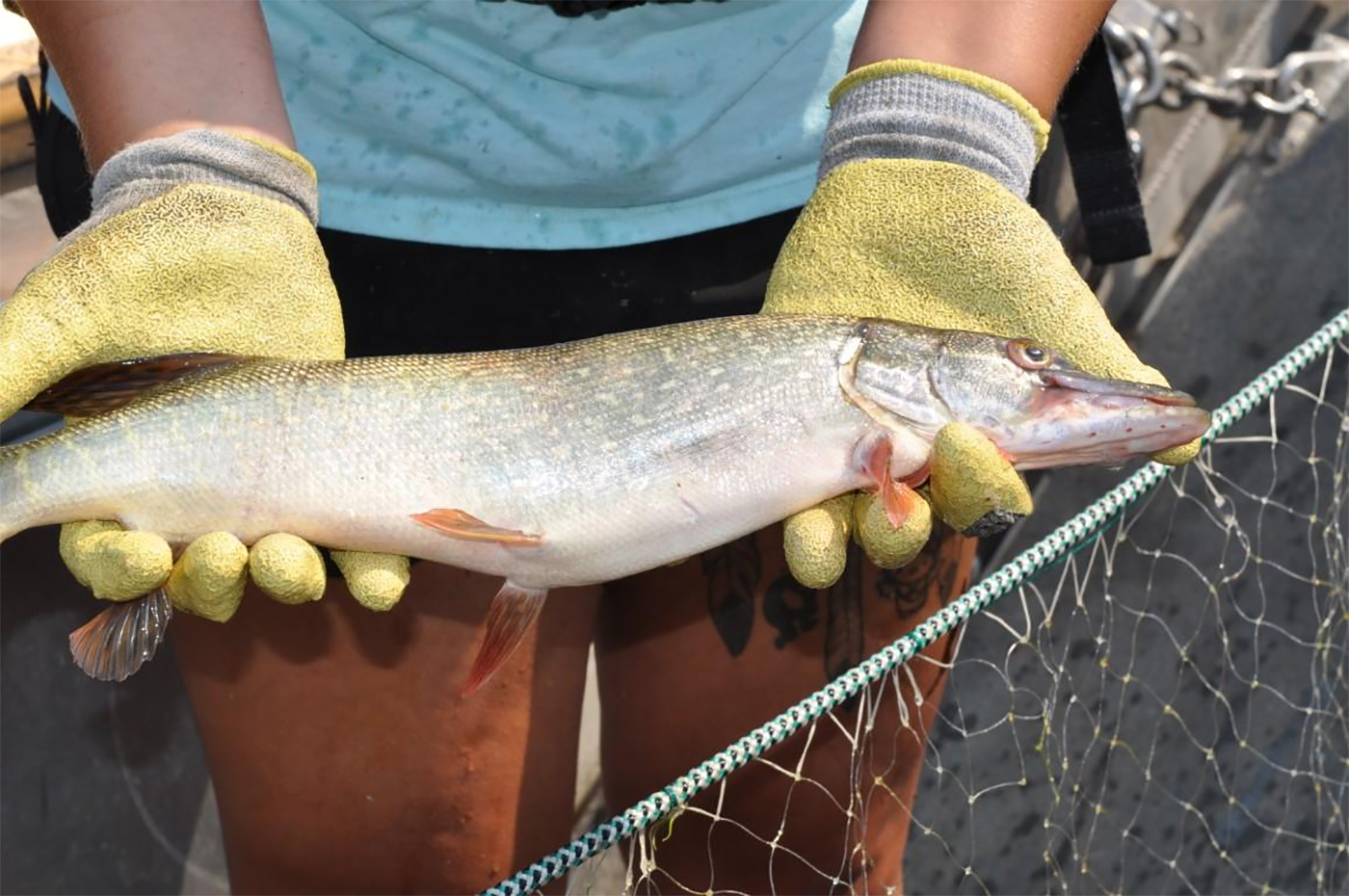
In Lake Roosevelt, the thruway battle is beingness led past the Spokane Tribe of Indians and the Confederated Tribes of the Colville Reservation.
"Expressway have the ability to eradicate some of our native salmonids that we're trying to conserve and protect," said Holly McLellan, a fisheries biologist for the Colville Confederated Tribes. "We're trying to eliminate pike from Lake Roosevelt, and we're really concerned virtually motorway spreading through the [Columbia] system."
Lake Roosevelt is the Columbia River impounded backside Grand Coulee Dam, which has blocked passage of ocean-going – anadromous – salmon and steelhead for some 80 years. More recently, in the 1950s, Primary Joseph Dam, 55 miles downriver from Grand Coulee, also blocked anadromous fish passage.
Equally the population of Northern Pike in Lake Roosevelt grows – pike were first noticed there in 2011, and the population has been growing always since – the threat increases to fisheries in the lake that are supported by the Colville and Spokane tribes, and likewise potentially to fish in the rivers of North Central Washington downstream of Chief Joseph. Those rivers provide spawning habitat for upper Columbia steelhead and Leap Chinook salmon, an endangered species.
Thus, the business concern well-nigh pike, and the potential impacts, extend beyond the lake and its fisheries, which have financial, recreational, and cultural importance.
Oregon Quango member Ted Ferrioli chosen the motorway suppression effort in the lake "an example of an exigency that needs to be responded to," one that transcends an isolated projection to become a regional business. "This is a house fire," he said.
Slowing a delinquent species
In the race against fourth dimension and the rapid-fire spawning and expansion of the Northern Motorway population in Lake Roosevelt, there is a hopeful example that an aggressive campaign confronting the predator tin exist successful.
Northern Pike in the Pend Oreille River, a Columbia River tributary in Northeastern Washington, exploded some x years ago simply since take been beaten dorsum past the Kalsipel Tribe using the same techniques that the Spokane and Colville Tribes are using in Lake Roosevelt. The Pend Oreille River is the outlet of Lake Pend Oreille and joins the Columbia just due north of the border in British Columbia.
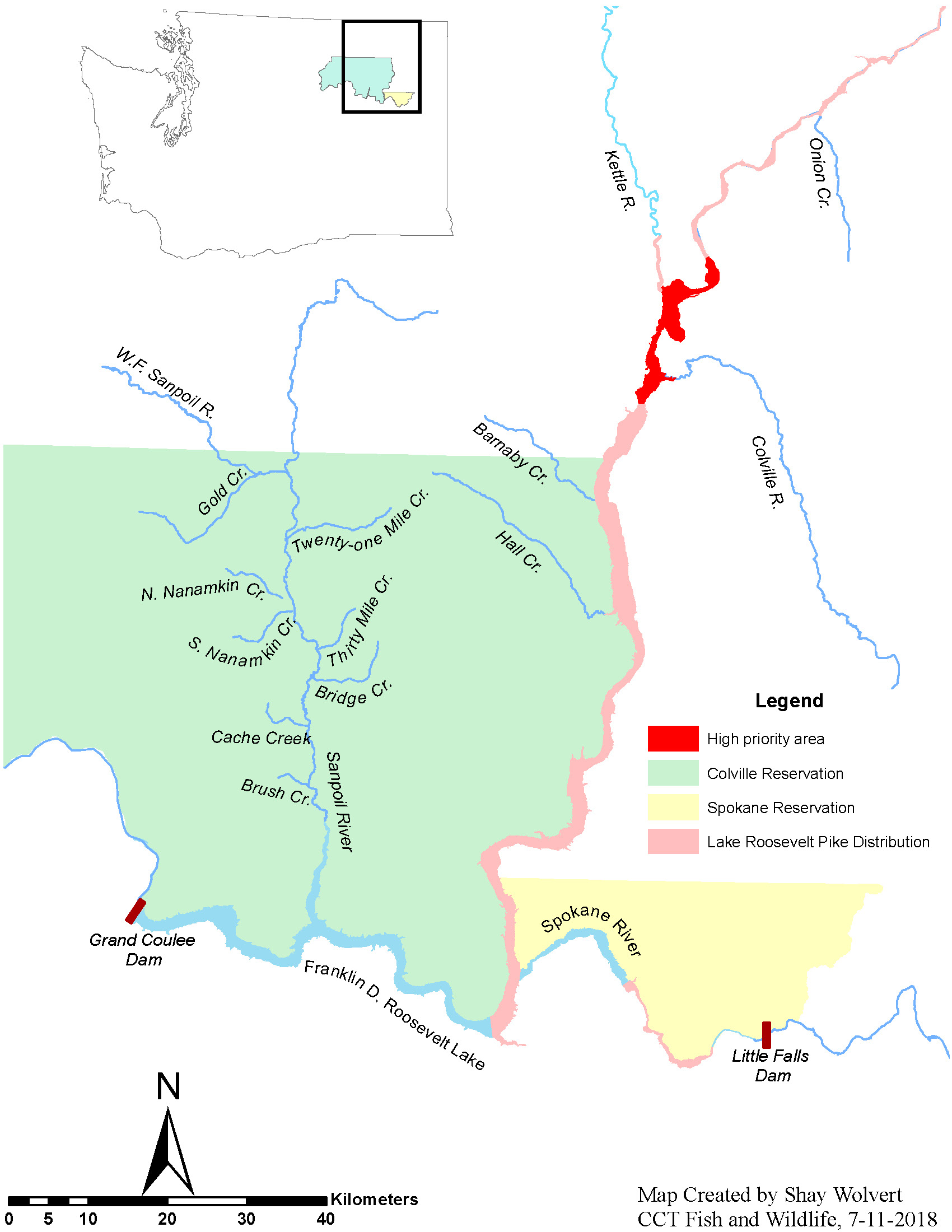
Map of state highway locations
Motorway apparently established in the reservoir backside Box Canyon Dam in 2004, and numbered an estimated 400 fish by 2006. The population exploded to about five,500 by 2010. Most other fish species in the river declined. The Tribe began an intensive gillnet fishery to grab as many Northern Pike as possible. That twelvemonth the tribe caught nearly 6,000. The suppression effort continued with gillnets and advantage fisheries for sport anglers, and past the leap of 2017 the Tribe caught only 34 pike. In 2018 the number was 271.
"We were pretty excited," Kalispel Tribe Fisheries Director Joe Maroney said. "There was a lot of attention given to this where a lot of people in the Columbia Basin thought that we could not do it."
Only they have.

To engagement, the Kalispel Tribe has removed a total of 18,000 Northern Motorway from the Pend Oreille River, almost all of them in the reservoir backside Box Canyon Dam. The Tribe likewise is working on expressway removal in the next reservoir downriver, the one behind Boundary Dam. There are fewer throughway in that reservoir, and gillnetting in that location appears to have reduced pike abundance by well-nigh 80 percent, Maroney said.
In 2018, the Spokane and Colville tribes, co-managers of fisheries in Lake Roosevelt with the Washington Department of Fish and Wildlife, killed approximately 1,600 Northern Freeway through gillnetting. Another 435 have been killed past sport anglers through the reward fishery, which is funded by the Colville Tribes. In 2017, anglers turned in 619 heads.
Maroney told the Columbia Basin Bulletin in July that the sharp decline in the Pend Oreille River state highway population over a 5-year flow shows the effectiveness of intensive gill netting, which has been gradually reduced to match the declining catch.
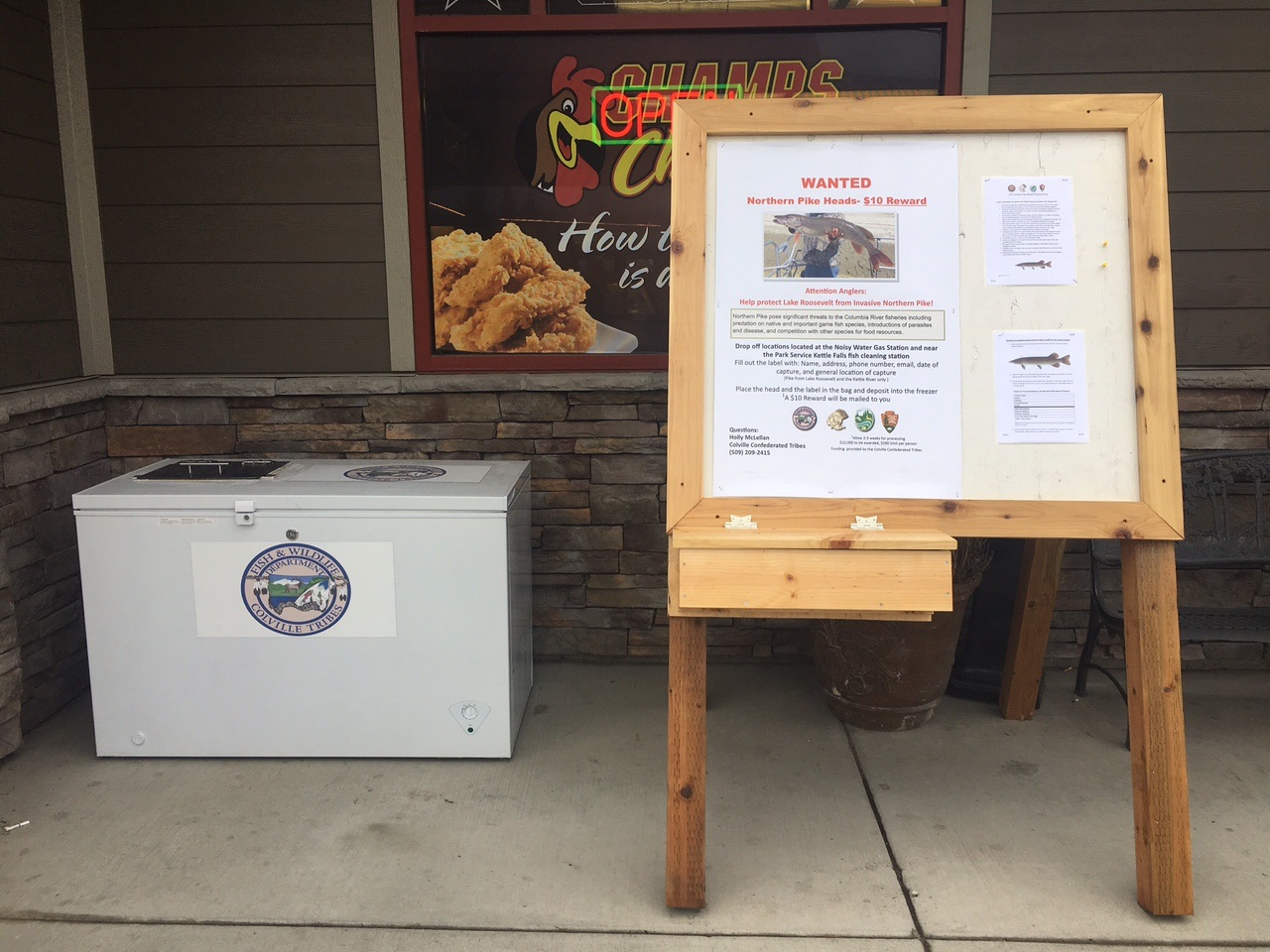
Informational affiche and freezer for pike heads
He as well has been thinking well-nigh the potential economic touch of a superhighway invasion into the Columbia River Bowl, including Lake Roosevelt. Using a model developed in California to assess the touch of a motorway invasion in Lake Davis northeast of Sacramento, Maroney estimated the impact at $33 one thousand thousand for Washington alone, a figure he chosen "crude" because he made assumptions to go a full general idea. He titled a Northern Motorway presentation he gave to a March 2018 meeting of the Washington Salmon Recovery Funding Lath, "You should be afraid … Be Very Afraid."
And in that location is another business organisation with pike, one that could menace sport anglers: chemic contamination. In July 2012, the Washington Country Section of Health issued an advisory for Pend Oreille River pike consumption, warning people not to eat expressway over 24 inches long because the fish accumulate mercury in their flesh, and past the time a throughway has reached that length its mercury concentration is dangerous. Thruway nether 24 inches can exist consumed, only the Department advises just two meals per month.
What well-nigh pike in Lake Roosevelt?
Holly McLelllan, primary fisheries biologist for the Colville Confederated Tribes, said tissue samples were nerveless in July from motorway in Lake Roosevelt for analysis by the Ecology Protection Agency. "We await a fish-consumption advisory by the stop of the year," she said.
Eradication partners
A small regular army has been raised to fight the presence of Northern Pike in Lake Roosevelt, including the land of Washington, the Spokane and Colville tribes, and the three mid-Columbia public utility districts that own five dams on the Columbia River downstream of Chief Joseph and Grand Canyon dams.
The Douglas County Public Utility Commune, which owns and operates Wells Dam, the offset downriver from Chief Joseph, is watching the pike suppression try advisedly.
While Douglas is non contributing to the current suppression attempt, "we stand ready to fund suppression efforts in Wells, should pike be identified in that section of the Columbia River," utility spokeswoman Meaghan Vibbert said.
"Pike are on our radar for sure," said Steve Hemstrom, a senior fisheries biologist for the Chelan County Public Utility District in Wenatchee, which owns and operates Rocky Attain and Rock Isle dams, the second and third dams downriver from Chief Joseph.
Bill Towey, a fisheries scientist for the PUD, said the utility is very concerned near the Northern State highway presence in Lake Roosevelt and the Columbia River Bowl and supports the continued suppression and early on detection efforts.
Hemstrom said he'south confident pike will be detected in the fish-passage facilities at the Rocky Attain and Rock Island dams if they entrain over M Coulee and Chief Joseph. And then far, none has been detected.
While that could change, Hemstrom thinks information technology is unlikely. H2o flows by and through the two dams more quickly than in slow-moving Lake Roosevelt, and the Columbia near Wenatchee has fewer shallow backwater areas superhighway prefer. Thus, salmon and steelhead smolts motility through the area chop-chop, perhaps too fast for freeway.
"We know that pike are not hunt predators; they are burst-and-ambush predators," he said. "So would they prey on salmon that are moving quickly? Probably not. Do the migrating salmon go into backwater places where motorway like to hide? Probably not."
Tom Dresser, of the Grant County Public Utility District, which owns and operates Wanapum and Priest Rapids dams on the Columbia, the fourth and fifth dams downriver from Chief Joseph, said the utility is keeping a shut lookout for pike.
"Grant PUD has crews on the water from mid-March through October of each year, five days per week (Monday-Friday)," Dresser said. "If freeway were detected, crews can be redirected within a matter of hours to that location to employ suppression and removal efforts. I believe that Grant PUD is in a good position to detect and respond if necessary."
The experiences of pike investigations in Canada might give some pause, however. Canadian researchers found freeway are extremely adaptable and able to easily survive along rocky shorelines and in fast-moving rivers, non only in their preferred habitat of shallow lake and river waters. If there is a likely spot where pike might take concur downstream of Master Joseph, a sort of point of commencement contact, a broad spot along the northward shore of the river called Lake Pateros, after the side by side urban center, Pateros, is a skillful candidate. Biologists are watching it carefully. The habitat there is similar to the areas around the mouths of the Kettle and Colville rivers in Lake Roosevelt that expressway adopt.
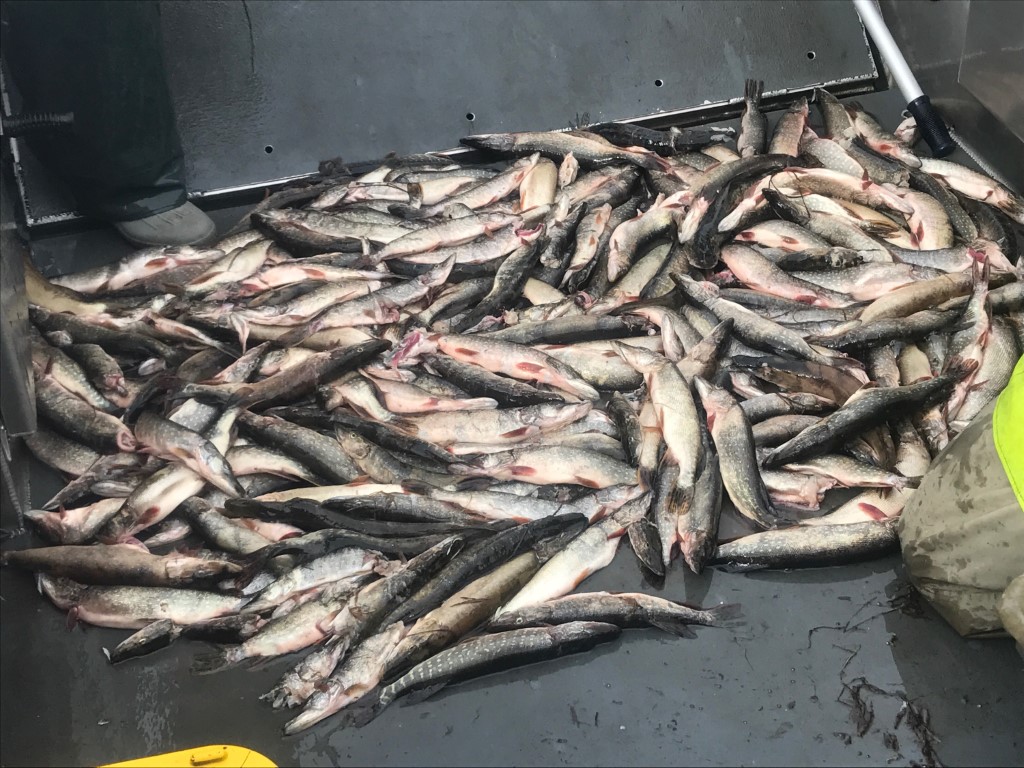
Juvenile pike from the mouth of the Colville River
Salmon and steelhead spawn in Columbia River tributaries, and those fish might be afflicted by pike if they get beneath Chief Joseph, a potential the Chelan PUD recognizes.
"We're withal evaluating this," Hemstrom said.
The Quango has a web-based tool, hither, that provides current Northern Pike suppression information, information on the treats the predator poses, and information most how the public tin can help proceed pike from reaching anadromous waters below Chief Joseph Dam.
But the Columbia below Chief Joseph Dam as well has what might prove to be a secret weapon against pike, he said: Stickleback, a carnivorous fish that don't grow very large – most four inches long at best – only take a broad appetite that includes insects, pocket-size crustaceans, and fish larvae.
"Stickleback are predators on pike eggs, and we have gobs of stickleback," Hemstrom said. "Fifty-fifty if motorway could spawn in these areas, the sticklebacks would eat them, near probable."
One complexity of the pike suppression effort, potentially at to the lowest degree, is that there is no coordinated plan of assail if pike take concur downstream of Master Joseph. Washington'due south Invasive Species Council is working to change that past, for example, proposing the creation of a state emergency-response fund and facilitating the evolution of a plan for how to respond to the continued spread of Northern Expressway.
"We need a plan besides as funding," the Quango's executive coordinator, Justin Bush, said. "In terms of invasive species, Northern Pike is ane of our highest priorities. "Some species, we know, would be more dissentious to our infrastructure and natural resources, like zebra and quagga mussels, simply they are not currently here."
Zebra and quagga mussels form hard masses of finger boom-sized shells that tin clog water intakes and other submerged structures such as equipment at dams. They accept infested areas of the Midwest and Southwest, only so far not the Northwest.
Greer Meier, Science Programme Manager for the Upper Columbia Salmon Recovery Lath in Wenatchee, said the board is tracking and participating in pike-suppression forums, every bit well as staying in contact with the public utility districts equally they watch for freeway.
"Our Upper Columbia listed salmon and steelhead could face a major threat from these fish moving downstream and occupying the reservoir areas where juveniles are migrating and rearing," she said.
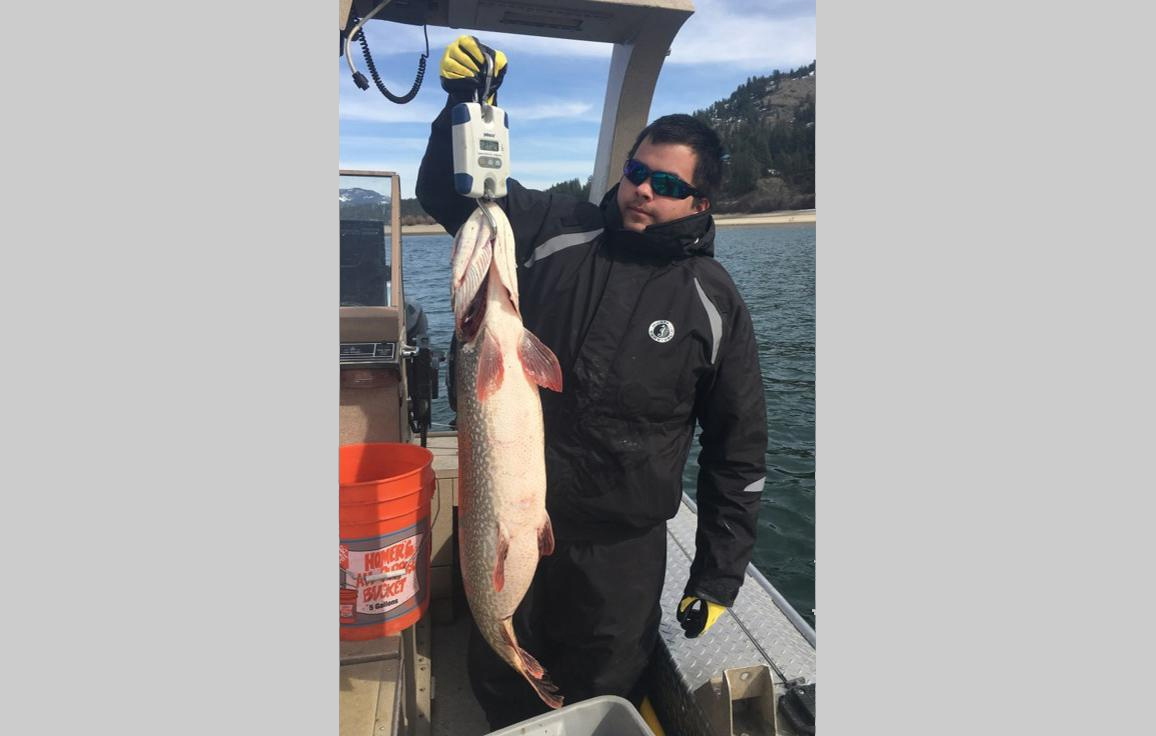
Huge pike with xvi" kokanee in its stomach
The Western Governors' Association has identified Northern Pike as one of the top threats in the West and established the Biosecurity and Invasive Species Initiative to focus attention on the impacts that invasive animals, plants, pests, and pathogens have on ecosystems, forests, rangelands, watersheds, and infrastructure in the Western United States. Workshops on challenges and opportunities in addressing invasive species are planned, and the Initiative could assist coordinate a rapid response or leverage federal funding in the future to fight the problem.
Elsewhere, the Coeur d'Alene Tribe of Indians as well is working to eliminate Northern Throughway from parts of Lake Coeur d'Alene, where the species was introduced illegally. In a letter to the region in August 2018, Caj Matheson, director of the Tribe's Natural Resource Section, wrote that targeted suppression efforts to remove motorway from Windy Bay to protect native Westslope Cutthroat Trout and Bull Trout have been promising and that the Tribe plans to expand suppression efforts across Windy Bay with a "large-scale suppression effort" in 2019.
Angelo Vitale, fisheries program manager for the Tribe, said there have been "some very positive responses to this early work," adding, "the Tribe is committed to redoubling its effort to implement a large scale suppression strategy to bolster the production of culturally important species similar westslope cutthroat trout and bull trout."
He said the strategy is well aligned with the mission of the Tribes to promote the recovery of native fisheries for the benefit of time to come generations. It too seems to be well aligned with the interests of the angling community, he added.
"Notably, the responses by anglers to a 2017 survey indicated wide back up for both native species conservation efforts equally well as for management strategies that aim to reduce the negative impacts of Northern Pike on more desirable fisheries," Vitale said.
Science and pike
In a reservoir the size of Lake Roosevelt, information technology is critical to be able to pinpoint the pike hotspots and fish for them at that place. Picking the places to set nets is not random guesswork.
"We have a shape file of the reservoir that shows where the areas of shallow water are, less than 25 feet," said Holly McLellan, chief fisheries biologist for the Confederate Colville Tribes. "They like shallow water. We try different areas, and if we get a lot of fish we will stay there, and if not nosotros movement on."
The oral cavity of the Colville River has been a freeway hot spot, partly because pike casualty on juvenile burbot and the Colville produces a lot of burbot. When pike spawn they tend to move out of that area and go across the river and upstream to the oral fissure of the Kettle River, another state highway hotspot, McLellan said.
While information technology isn't clear how superhighway got into Lake Roosevelt in the commencement identify, microchemistry assay might help unlock that mystery. It is known that expressway invaded some lakes and rivers in Montana, including several that are in the Columbia River Basin, some time ago, and subsequently were found in the Pend Oreille and Columbia rivers.
So motorway could take migrated downriver into Lake Roosevelt from the Pend Oreille, or they could have come up from British Columbia, where pike also have been institute in the Columbia River. Or they could have come from the Spokane River, or they could accept come from who knows where in buckets and dumped in the lake.
Details nearly each pike are noted on a clipboard, and the information later transferred to a reckoner. With this information, biologists can judge the age and health of fish in the reservoir, and know how many were caught and where they were caught.
The Spokane flows from Lake Coeur d'Alene, and biologists are concerned the lake could be feeding pike into the Spokane River and Lake Roosevelt. Equally a upshot, biologists have been watching the Spokane River closely. Superhighway are occasionally observed in the riverine section of the Spokane River from the Washington state line downstream to Nine Mile Dam. Between 9 Mile Dam and Long Lake Dam, referred to equally Lake Spokane, a robust Northern Expressway population exists. Petty attention has been given to this population due to a lack of funding. However, fishery managers realize it could be a possible source of state highway in Lake Roosevelt. In 2017 and 2018, biologists collected at least 5 Northern Superhighway from the Spokane Arm of Lake Roosevelt.
Meanwhile Dr. Kellie Carim, a scientist with the U.Due south. Forest Service's Rocky Mountain Research Station in Missoula, Montana performed genetic analysis to understand the distribution of motorway in the Columbia River Bowl and to place the original source populations that led to the invasion in eastern Washington.
Dr. Carim collaborated with the Colville Confederated Tribes to collect environmental Dna (eDNA) samples inin the Fall of 2017 and the Spring of 2018 from Lake Roosevelt and some of its tributaries (the Kettle , Colville , Sanpoil, and Spokane rivers, and Wilmont and Militarist creeks, which are almost the mouth of the Spokane River). Environmental DNA is DNA from an organism that is sloughed off and left backside in the surrounding environment. By collecting water samples, biologists find an animal just by looking for its Deoxyribonucleic acid in the water sample.The eDNA samples showed positive detections of freeway from the upper office of Lake Roosevelt down to Wilmont Creek, also as in lower reaches of the Spokane River. This distribution is consistent with previous reports of live superhighway in these areas of Lake Roosevelt. To improve understand whatsoever changes in the distribution of freeway in Lake Roosevelt, Dr. Carim and the Colville Confederated Tribes will proceed to collect eDNA samples in both the spring and the fall. This will allow them to apace identify whatever further spread of pike in Lake Roosevelt. Changes in pike presence between spring and autumn samples will also provide information on where pike tend to reside during the spawning and growing seasons.
To sympathize the original source of pike in recently invaded areas of the Pend Oreille River and Lake Roosevelt, Dr. Carim compared the genetic makeup of fish in these areas to other potential source populations in the Coeur d' Alene River and Clark Fork River drainages in Idaho and Montana. Although established superhighway populations in the Clark Fork River drainage (including Lake Pend Oreille) are closest geographically to the newly invaded areas in the Pend Oreille River of eastern Washington, genetic analysis suggested that fish from the Clark Fork River drainage are not the source of fish in recently invaded areas of eastern Washington. Instead, many motorway in the Pend Oreille River and Lake Roosevelt are near genetically similar to state highway in Medicine and Cave Lakes, 2 minor lakes located upstream of Lake Coeur d'Alene in Idaho. These data suggest that fish arrived in the Pend Oreille River by illegal human transport considering there is no direct water connection betwixt lakes Coeur d'Alene and Pend Oreille. However, there are some pike in the Pend Oreille River and Lake Roosevelt that are not related to any of the established pike populations in the current database. This suggests that fish may have too been introduced to eastern Washington from additional populations outside the Clark Fork and Coeur d'Alene River drainages.
Chemistry also is an important tool in the search for the origins of Lake Roosevelt motorway. Scientists for the Colville Tribes are testing chemical elements in the h2o of Lake Roosevelt and its tributaries and comparing the elements with those plant in the ear basic, or otoliths, of expressway, where the elements accumulate as the fish grows. In item, researchers expect for strontium. Each stream has a unique strontium isotope signature.

"So if you lot look at the otolith and analyze from the center out, the strontium signature changes over time if the fish moves into dissimilar bodies of h2o," McLellan said. "Nosotros have cataloged almost of the major bodies of water in the expanse. We are then able to match the water and otolith signatures. This is how we can tell which trunk of h2o a pike originated from and where it moved from ane system to another. For example, the Kettle River has a much lower strontium signature than Lake Roosevelt. So we were able to verify that Northern Pike were spawning in the Kettle River, and then migrating out of the Kettle River into Lake Roosevelt to rear."
To date, the tribes have identified spawning areas in the Kettle and Colville rivers and in Lake Roosevelt near the community of Evans northward of Kettle Falls. State highway from Lake Roosevelt will be tested to determine if they came from the Pend Oreille River and motorway from the Spokane River will exist tested to decide if they came from Coeur d'Alene Lake. This information volition help the Spokane and Colville tribes focus suppression efforts in the proper locations.
Considering simply the fish in eastern Washington, many of the pike in Lake Roosevelt are virtually closely related to those immediately upstream in the Pend Oreille River. These data suggest that later on fish were introduced into the Pend Oreille River, they spread downstream into Lake Roosevelt. Biologists with the Colville and Spokane Tribes have documented active reproduction of pike in Lake Roosevelt. Consequently, Lake Roosevelt is being populated by both natural reproduction within the watershed and immigration from upstream waterbodies.
Illegal man introductions of pike take occurred in Idaho and Montana since the 1950s, and continue today. Dr. Carim and the Colville Confederated Tribes take identified a few established motorway populations that are the likely source of illegal introductions to eastern Washington. However, the information besides suggest that additional populations demand to be considered in this enquiry. Dr. Carim is seeking funding and partnerships with collaborators to collect samples from additional established pike populations in Montana, Idaho, and Canada. Data from boosted established throughway populations volition help biologists understand how pike take moved both naturally and with human being assistance throughout the Columbia River Bowl.
Scientific inquiry also is focusing on the type of gear used to take hold of pike.
"Gill net textile, dimensions, structure, and deployment strategy all influence fish catch rates," said Elliott Kittel, a fisheries scientist with the Spokane Tribe of Indians. "With the Colville Tribes we are jointly experimenting with several types of nets to maximize pike catch and minimize bycatch."
The tribes have been experimenting with two different net materials, a monofilament net in different mesh sizes and made of the same clear material used past commercial fishers to catch salmon in the lower Columbia, and a multifilament net that is constructed of braided nylon. In Lake Roosevelt, the monofilament nets have the drawback of "catching a lot of fish we're not targeting, including walleye," a popular recreational fish, McLellan said.
"The white sturgeon researchers in Lake Roosevelt use the braided nylon nets and noticed that their only bycatch was Northern Superhighway, and nosotros idea that was really interesting," McLellan said. "And so we idea we would experiment with it, besides."

Preliminary catch information is promising, with loftier Northern Pike catch rates and depression bycatch of non-targeted fish in the braided nets, McLellan said.
The Colville Tribes have been experimenting with two-inch stretch mesh, and the Spokane Tribe is experimenting with several other mesh sizes. At the finish of the year, the agencies will combine their datasets and employ the information to select nets that are efficient in Lake Roosevelt. Nonetheless, each bounding main is different, and what works well in 1 may not piece of work very well in some other. For example, the Kalispel Tribe experimented with braided nylon nets, but they were not constructive because the Pend Oreille system has lots of Yellow Perch that filled their nets. Agencies need to acquire from other agencies and adapt strategies that will piece of work best in their waters, McLellan said.
Who pays?
Funding for the motorway suppression effort in Lake Roosevelt comes from a joint commitment of the tribes, Bonneville Power Administration, Washington Section of Fish and Wildlife, the Bureau of Indian Affairs and others including the Chelan and Grant public utility districts, which own a full of iv dams on the Columbia. Information technology is a requirement of the PUDs' federal licenses to operate the dams that they fund projects to improve habitat and dam-passage for fish, peculiarly salmon and steelhead, and wildlife that are afflicted past the dams. Pike potentially threaten those investments.
While the Chelan PUD provided $50,000 final yr toward the Lake Roosevelt try, the Colville Tribe $35,000, and WDFW $15,000, funding has come up primarily from the Bonneville Power Administration, although in 2018 the Colville and Spokane tribes augmented the Bonneville coin with some of their ain funding, and the Grant County Public Utility District committed $75,000 for the iii-yr, 2017-2019 catamenia. In 2018, the 2 tribes submitted a proposal to the Council for Bonneville funding for the next three fiscal years, 2019-2022, for about $4.5 million, or nearly $900,000 a yr, with a commitment to seek boosted funds from other entities including the state of Washington, federal agencies, and the 3 mid-Columbia Public utility districts.
The delivery to seek additional sources of funding besides from Bonneville resonated with the Council members. At its June 2018 coming together, the Quango unanimously recommended the project to Bonneville for funding.
"There is a need for seed money for this [throughway suppression] project, and one thing I similar about information technology is that the partners are aggressively seeking other, permanent, funding so it won't just exist from Bonneville," Idaho fellow member Bill Berth said. Guy Norman, a Washington member of the Council and chair of the Quango's Fish and Wild fauna Committee, agreed, adding he was pleased that "the partners are focused on reducing the threat to Lake Roosevelt, and also to anadromous fish downstream."
In June, the Spokane Tribe was notified information technology had received a 2nd round of funding totaling $144,000 from the federal Bureau of Indian Diplomacy (BIA), and in late August McLellan learned the Colville Tribes will receive a $104,000 grant from the Bureau of Indian Affairs.
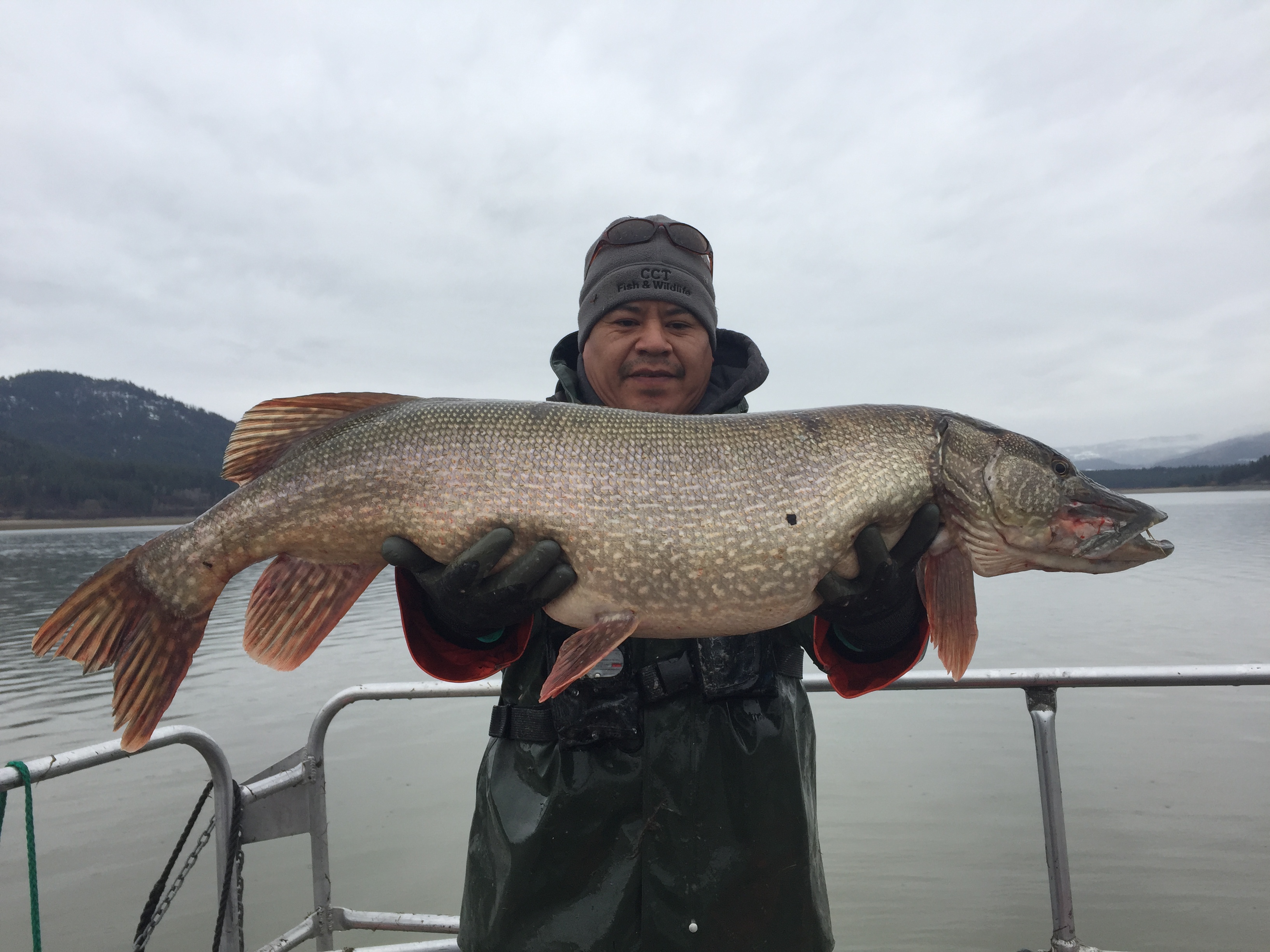
xx-pound freeway from Colville River
"The money is for one year, through September 2019, and I will demand to re-apply next summer," she said. "These funds, combined with our Bonneville Ability funds, now gives me plenty security to hire a new biologist to help me run this project."
In September, the Council approved a request from the Spokane Tribe and the Washington Department of Fish and Wildlife and recommended that Bonneville direct $301,473 of cost savings from other projects to the thruway suppression project in 2019.
Helping to support the diverse funding proposals and requests, the suppression projection is supported by the Quango's Independent Scientific Review Panel (ISRP). According to a memo prepared by the Quango'due south Fish and Wild fauna Partitioning staff, the ISRP reported that the proposal met the criteria for a brusk-term suppression attempt "that could quickly and significantly modify the abundance of Northern State highway and provide additional information regarding the status of the species in the Upper Columbia Bowl." The panel included specific qualifications intended to strengthen the proposal in lite of what the memo called the "urgent need to go a better understanding of the command and suppression of Northern Pike in Lake Roosevelt."
An uncertain future
Information technology's hard to exist optimistic almost a trouble that has such explosive potential to impact fisheries throughout the Columbia River organisation.
From what seemed like a harmless fish that's fun to catch, the specter of monster in our midst has grown.
"We view expressway as a problem, not as a fishery," said Chris Donley, Region 1 Fish Plan Manager for the Washington Department of Wildlife in Spokane. The department'due south policy regarding pike is simple: If you grab one, you tin't release it live. You have to kill it." The Section maintains a website on Northern Pike, here.
"Science is a learning process," said Justin Bush, executive coordinator of Washington's Invasive Species Council, a division of the country's Recreation and Conservation Role. "In Washington Northern State highway was a game fish until 2011, and at present it is a prohibited, aquatic invasive species. When we realized the impacts, the nomenclature was changed. Nosotros see this as an imminent threat, and we are worried about information technology economically too equally biologically."
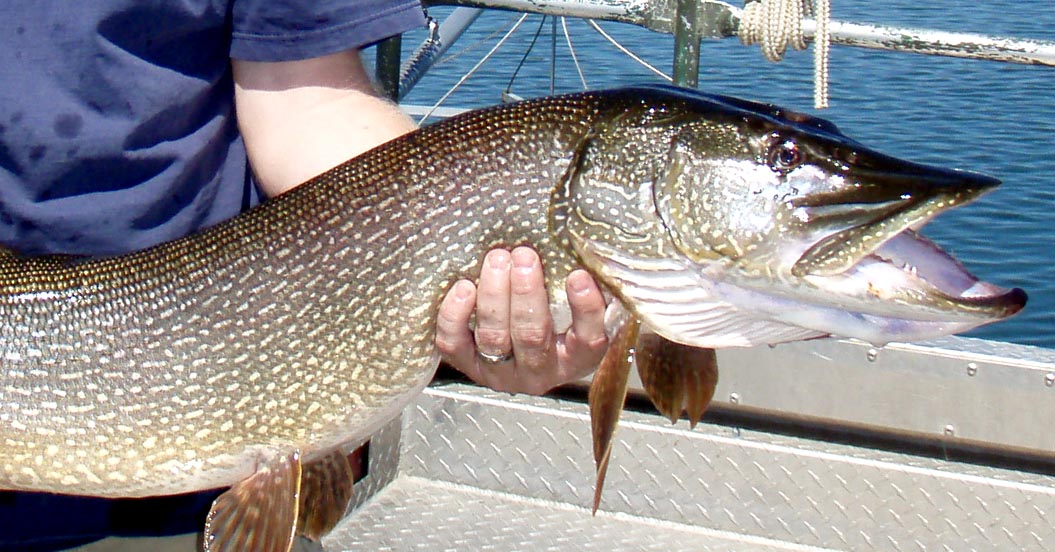
Pike caught by Kalispel fisher
He said pike threaten tribal, commercial, and sport fisheries and, if they constitute downriver of Principal Joseph Dam, pike threaten the state's substantial funding of salmon recovery efforts. Since 1999, the Washington State Salmon Recovery Board has directed $731 one thousand thousand for piece of work to, primarily, better salmon habitat, he said.
"In my observation, the state highway state of affairs in Lake Roosevelt is a growing concern," said Elliott Kittel, a fisheries biologist for the Spokane Tribe, said. "We take merely very recently been able to reorganize internal funds toward thruway suppression. Defended funding will be required to adequately combat pike population growth and expansion."
The fish, and the trouble, could exist migrating ever closer to the anadromous zone below Primary Joseph Dam.
"Nosotros are finding pike farther due south in Lake Roosevelt with more regularity than ever before," Kittel said. "Pike abundance appears to be increasing in the Kettle Falls area, likewise. The showtime motorway was collected in the Spokane River Arm of Lake Roosevelt at the cease of 2017, and more have been collected since."
Holly McLellan, chief biologist for the Colville Confederated Tribes, said the tribes hypothesize that throughway are moving downwards the reservoir at the charge per unit of almost 50 kilometers, or 31 miles, per twelvemonth.
The mouth of the Kettle River is 109 miles from Grand Coulee Dam; the oral fissure of the Colville River is 100 miles. Both are infested with state highway. The oral fissure of the Spokane River is 43 miles from Grand Canyon, and recently an angler caught a freeway in Militarist Creek, which is downstream from the mouth of the Spokane River and just 31 miles higher up the dam.
They eat anything in their path and they threaten important fisheries in Lake Roosevelt and potentially salmon and steelhead downstream in the Columbia River. The state'due south TVW channel produced a special program about the superhighway invasion. Watch it here .
Source: https://www.nwcouncil.org/fish-and-wildlife/topics/pike-problem/
0 Response to "what fish is illegal to own in washington state"
إرسال تعليق